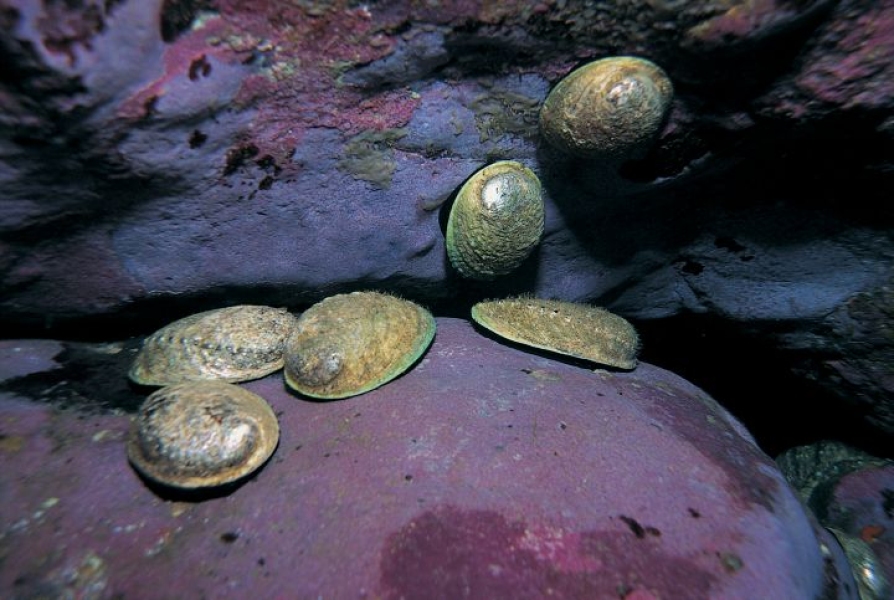The scientific name for New Zealand’s iconic black-footed pāua captures its shape and iridescent hues perfectly: Haliotis iris means ‘ear-shell rainbow’.
The scientific name for New Zealand’s iconic black-footed pāua captures its shape and iridescent hues perfectly: Haliotis iris means ‘ear-shell rainbow’.
Pāua (aka abalone) are a type of large edible sea snail of which there are about 55 species worldwide. The black-footed pāua is the most common of New Zealand’s three native pāua species. The others are the queen or yellow-footed pāua Haliotis australis and the virgin pāua Haliotis virginea.
Pāua could be considered shellfish royalty because their blood is blue. “The light blue tinge comes from the copper-based protein that carries oxygen in their blood,” says NIWA fisheries scientist Reyn Naylor. This contrasts with the iron-based oxygen-carrying protein (haemoglobin) in human blood, which gives it the red colour.
Pāua ‘breathe’ by extracting oxygen from seawater as it passes over their gills. The used water is expelled through the row of holes in their shell, along with waste products.
“Black-footed pāua are often found in large groups. They are found all around the New Zealand coastline, most commonly in shallow waters on rocky shores from low tide up to depths of 10 metres. They cling to rocks using their strong muscular ‘foot’, the part we eat.
“There is much variation in the size of pāua around the country – up north they don’t get that big. There seems to be a correlation between water temperature and size. This could be because their preferred algae food is more abundant in colder waters, but it could also be due to physiological factors,” says Mr Naylor.
The beautiful iridescent pāua shell – which changes colour when you look at it from different angles – is made up of very thin layers of calcium carbonate and protein. The brown patches on the inside of the shell are thin layers of protein. The calcium carbonate (CaCo3), is a mixture of very thin, tile-like crystals, and it’s the diffraction of the light when it passes through these crystals that gives the stunning colours.
The seaweed they eat also seems to affect their colour, says Mr Naylor. In beds of giant kelp they have very deep blue colours inside the shell. Pāua in other areas seem to have lighter green to pink colours.
Coralline algae – a type of encrusting red algae – produce chemicals which actively promote settlement and early development in pāua larvae. Preliminary research by NIWA suggests that some species of coralline algae are preferred by pāua larvae and offer them a better start in life.
Scientist bio:
Reyn Naylor is a fisheries scientist who has worked with pāua since he began work at NIWA in 1991. He has been involved in projects using stable oxygen isotopes to measure age and growth in pāua. A qualified diver, he surveys the main commercial pāua fisheries and pāua stocks.
|
Species Fact File |
|
|
Common names: |
Paua, black-footed (or blackfoot) paua, abalone (US), ormer shell (UK), sea ear |
|
Māori name: |
Pāua |
|
Scientific name: |
Haliotis iris |
|
Type: |
Shellfish, marine gastropod mollusc (sea snail). |
|
Family: |
Haliotidae |
|
Size: |
Up to about 200 mm long (more usually 150–160 mm). Young pāua emerge from under rocks at about 70 mm in most places. |
|
Lifespan: |
Probably about 30 years. |
|
Diet: |
Seaweeds |
|
Reproduction: |
Males and females release eggs and sperm into the water column. Fertilised eggs produce tiny larvae which settle after about a week. |
|
Fishery: |
Pāua support important Māori, recreational, and commercial fisheries in many parts of the country. |
|
Things you need to know: |
Must be 125 mm long to harvest (except Taranaki: 85 mm). This allows them to spawn at least once before being harvested. The legal recreational catch limit is ten pāua per person per day and they must not be harvested using scuba gear. |
|
Something strange: |
Their blood is a light blue colour. |

